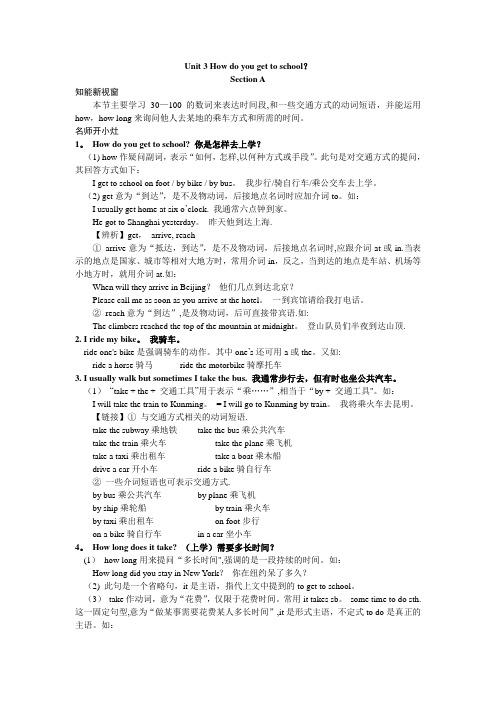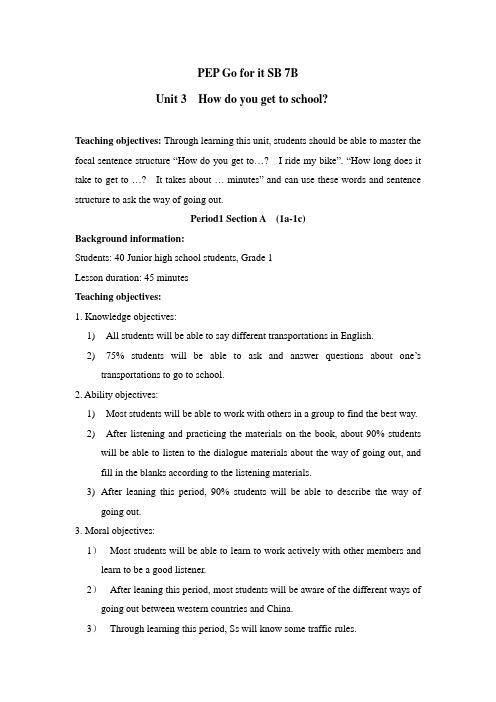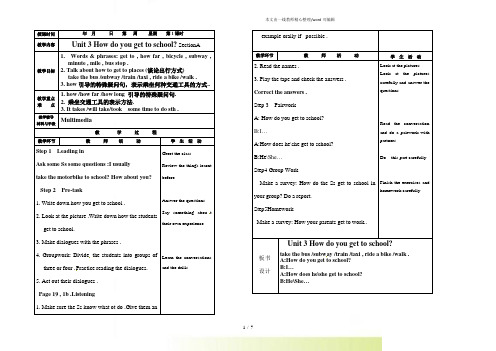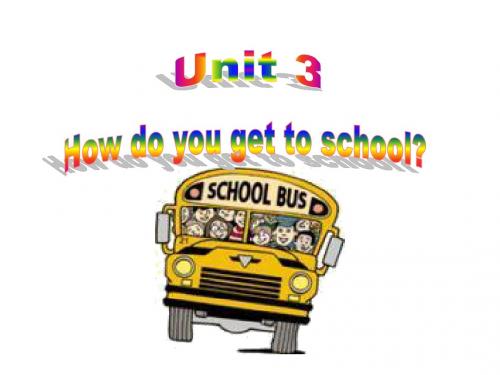English unit3-How do you get to school teching
- 格式:ppt
- 大小:1.51 MB
- 文档页数:22

七年级下册英语Unit 3 How do you getto school 教案和介绍后,老师可以通过展示一些图片或视频,引导学生谈论不同的出行方式,如乘坐公交车、地铁、骑自行车、步行等。
XXX1.首先,老师可以通过展示图片或视频,教授新单词和短语,如train、bus、subway、ride、bike、sixty、XXX、eighty、y、hundred、far、minute、kilometer、new、every、every day 等。
2.然后,老师可以模拟对话,让学生研究如何用英语谈论出行方式。
例如,老师可以问学生“How do you get to school?”,学生可以回答“I ride my bike”,或者老师可以问“How does Mary get to school?”,学生可以回答“She takes the subway”。
3.接下来,老师可以教授特殊疑问句,如“How far is it from…to…”和“How long does it take?”,并且教授如何回答这些问题。
例如,当学生被问到“How far is it from your home to school?”时,学生可以回答“It's 5 kilometers”,或者当学生被问到“How long does it take to get to school?”时,学生可以回答“It takes 40 minutes”。
Ⅲ。
Practice1.老师可以让学生进行小组讨论,讨论在不同情况下应该选择哪种出行方式,并且给出理由。
2.老师可以让学生进行角色扮演,模拟在不同场景下的出行方式和对话。
3.老师可以让学生完成一些练,如填空、选择题等,以检验他们对所学知识的掌握程度。
XXX1.老师可以引导学生了解不同国家的出行方式和交通规则,让学生了解和尊重不同文化和惯。
2.老师可以教授一些有关交通安全和礼仪的知识,让学生养成良好的交通惯和安全意识。

Unit 3 How do you get to school?Section A知能新视窗本节主要学习30—100的数词来表达时间段,和一些交通方式的动词短语,并能运用how,how long来询问他人去某地的乘车方式和所需的时间。
名师开小灶1。
How do you get to school? 你是怎样去上学?(1) how作疑问副词,表示“如何,怎样,以何种方式或手段”。
此句是对交通方式的提问,其回答方式如下:I get to school on foot / by bike / by bus。
我步行/骑自行车/乘公交车去上学。
(2) get意为“到达”,是不及物动词,后接地点名词时应加介词to。
如:I usually get home at six o’clock. 我通常六点钟到家。
He got to Shanghai yesterday。
昨天他到达上海.【辨析】get,arrive, reach①arrive意为“抵达,到达”,是不及物动词,后接地点名词时,应跟介词at或in.当表示的地点是国家、城市等相对大地方时,常用介词in,反之,当到达的地点是车站、机场等小地方时,就用介词at.如:When will they arrive in Beijing?他们几点到达北京?Please call me as soon as you arrive at the hotel。
一到宾馆请给我打电话。
②reach意为“到达”,是及物动词,后可直接带宾语.如:The climbers reached the top of the mountain at midnight。
登山队员们半夜到达山顶.2. I ride my bike。
我骑车。
ride one's bike是强调骑车的动作。
其中one’s还可用a或the。
又如:ride a horse骑马ride the motorbike骑摩托车3. I usually walk but sometimes I take the bus. 我通常步行去,但有时也坐公共汽车。

Unit 3 How do you get to school?(讲义)Words and Expressionstrain /treɪn/ n.火车bus /bʌs/ n. 公共汽车subway /'sʌbweɪ/ n. 地铁take the subway 乘地铁ride /raɪd/ v. 骑 n. 旅程bike /baɪk/ n. 自行车ride a bike 骑自行车sixty /'sɪksti/ num. 六十seventy /'sevnti/ num. 七十eighty /'eɪti/ num. 八十ninety /'naɪnti/ num. 九十hundred /'hʌndrəd/ num. 一百minute /'mɪnɪt/ n. 分钟kilometer /'kɪləmiːtə/ (= kilometre) (abbr. km) n. 千米;公里new /njuː/ adj. 新的;刚出现的every /'evri/ adj. 每一;每个every day 每天by /baɪ/ prep. (表示方式) 乘(交通工具)by bike 骑自行车far /fɑː(r)/ adv. & adj. 远;远的drive /draɪv/ v. 开车car /kɑː(r)/ n. 小汽车;轿车live /lɪv/ v. 居住;生活stop /stɒp/ n. 车站;停止think of 认为cross /krɒs/ v. 横过;越过river /'rɪvə(r)/ n. 河;江many /'meni/ adj. & pron. 许多village /'vɪlɪdʒ/ n. 村庄;村镇between /bɪ'twiːn/ prep. 介于……之间between…and…在……和……之间bridge /brɪdʒ/ n. 桥boat /bəut/ n. 小船ropeway /'rəup,weɪ/ n. 索道year /jɪə/ n. 年;岁afraid /ə'freɪd/ adj. 害怕;畏惧like /laɪk/ prep.像;怎么样villager /'vɪlɪdʒə(r)/ n.村民leave /liːv/ v.离开dream /driːm/ n.梦想;睡梦v.做梦true /truː/ adj.真的;符合事实的come true 实现;成为现实Dave /deɪv/ 戴夫(男名)Role-playLisa:Hey, Jane. Is this your new bike?Jane:Yes. I ride it to school every day. How do you get to school? Lisa:I usually take the bus.Jane:How far is it from your home to school?Lisa:I’m not sure…about 10 kilometers? The bus ride takes about20 minutes. How long does it take you to get to school? Jane:About 15 minutes by bike. It’s good exercise.Lisa:Yeah. Well, have a good day at school.Jane:You, too.练一练:将问句和答语连起来How does Mike get to school? How long does it take to get home? How far is it from here? It’s five kilometers. He rides his bike. About 15 minutes.Grammar FocusHow do you get to school?I ride my bike.How does she get to school?She usually takes the bus.How long does it take to get to school?It takes about 15 minutes.How far is it from your home to school?It’s only about two kilometers.Does Jane walk to school?No, she doesn’t. She goes by bike.Do they take the bus to school?No, they don’t. They walk.用适当的介词或者动词填空1.She often goes to work _______ bus.2.His father _______ the train to Beijing.3.Many people ________ (驾车)to work now.4.My mother comes here _______ train.5.Tom goes to school _______ his bike.6.Lucy often gets to school _______ her father’s car.7.I go to work ______ foot every day.ReadingRead the passage and answer the questions.Crossing the River to SchoolHow do you get to school? Do you walk or ride a bike? Do you go by bus or by train? For many students, it is easy to get to school. But for the students in one small village in China, it is difficult. There is a very big river between their school and the village. There is no bridge and the river runs too quickly for boats. So these students go on a ropeway to cross the river to school.One 11-year-old boy, Liangliang, crosses the river every school day. But he is not afraid. “I love to play with my classmates. And I love my teacher. He’s like a father to me.”Many of the students and villagers never leave the village. It is their dream to have a bridge. Can their dream come true?1.How do the students in the village go to school?____________________________________________________2.Why do they go to school like this?____________________________________________________3.Does the boy like his school? Why?____________________________________________________4.What is the villagers’ dream? Do you think their dream cancome true?____________________________________________________Exercises一、词汇填空1.My father usually takes the s__________ to work.2.It is three k__________ from my home to school, so I usually take the bus to school.3.I often r__________ my bike to school.4.There is a b__________ over the river.5.Today I sit b__________ Lily and Lucy.6.It’s not easy __________ (work) out the problem.7.There are __________ people and __________ water on the street. (much / many)8.There are three __________ (百) teachers in our school.9.My __________ (梦想) is to be a singer.10.Most of the girls ____________________ (害怕) dogs.11.The old woman lives in a small __________ (村庄).12.__________ (越过) the river and you will get there.二、单项选择( )13.—_____ do you get to school?—_____ my parent’s car.A. How; InB. How long; OnC. How far; InD. How; by( )14.—How does Mr. Smith go to work?—He usually______.A. by bus to workB. take the busC. goes to work to take a busD. goes to work on a bus( )15.—_____ it take you to walk from your home to your office?—At least(至少) 40 minutes.A. How far isB. How much time isC. How doesD. How long does( )16.—_____ is it from your home to school?—It’s three miles.A. How oldB. How farC. How muchD. How long( )17.It _____ about 15 minutes ____ the theatre.A. take; walkB. takes; to walkC. takes; to walk toD. take; to walk( )18.It is difficult ______ English well.A. learnB. to learnC. learningD. learns( )19.He is a ______ boy.A. five years oldB. five-year-oldC. five-years-oldD. five year old三、用所给的单词组短语,并用短语的适当形式填空20.to, school, get to, does, how long, take, it________________________________________________?21.school, your, from, it, is, how far, home, to________________________________________________?22.you, to, walk, do, school________________________________________________?23.ride, their bikes, do, school, your friends, to________________________________________________?24.He often goes to work by car.(就划线部分提问)__________ __________ he often __________ to work?25.It is four miles from my home to school. (就划线部分提问)__________ __________ is it from your home to school?26.It takes me twenty minutes to get home from school. (就划线部分提问)__________ __________ __________ it __________ you to get home from school?27.我认为她的梦想能够实现。

PEP Go for it SB 7BUnit 3 How do you get to school?Teaching objectives: Through learning this unit, students should be able to master the focal sentence structure “How do you get to…? I ride my bike”. “How long does it take to get to …? It takes about … minutes” and can use these words and sentence structure to ask the way of going out.Period1 Section A (1a-1c)Background information:Students: 40 Junior high school students, Grade 1Lesson duration: 45 minutesTeaching objectives:1. Knowledge objectives:1)All students will be able to say different transportations in English.2)75% students will be able to ask and answer questions about one’stransportations to go to school.2. Ability objectives:1)Most students will be able to work with others in a group to find the best way.2)After listening and practicing the materials on the book, about 90% studentswill be able to listen to the dialogue materials about the way of going out, and fill in the blanks according to the listening materials.3)After leaning this period, 90% students will be able to describe the way ofgoing out.3. Moral objectives:1)Most students will be able to learn to work actively with other members and learn to be a good listener.2)After leaning this period, most students will be aware of the different ways of going out between western countries and China.3)Through learning this period, Ss will know some traffic rules.Teaching contents:New words: the vocabulary of transportationSentence structures: How do you get to…? I ride my bike.How long does it take to get to …? It takes about … minutes.Focal points:V ocabularies: train, bus, subway, bike, walkSentence structures: How do you get to…? I ride my bike.How long does it take to get to …? It takes about … minutes.Lesson type: vocabulary, listening and speakingTeaching methods: activity, group work, game, making dialoguesTeaching aids: PPT, pictures, Bb, etcTeaching steps:Step1: Warming up (8minutes)Activity: Enjoy a short video (about the development of transportation)T: Good morning, everyone. First, let us enjoy a short video. After watching the video, you should tell me what transports did you see and later we will learn them, ok?(After watching the video)T: What transports did you see?S1: …T: Very well!S2: …T: Very good. Any more?S3: …T: Well down!Step2: Presentation and drill (17minutes)Activity 1: Listen and guess (Listen to the sound and guess what transport it is)T: You’ve mentioned a lot of transports. Now, let’s listen to the sound and guess what transport it is.Ss: …T: It’s a train/bus/car/bike (write the words on Bb).T: But, you know, my home is near. So I walk (performing the movement of walk and write the word on Bb) to school.Ss: (All students read words together)Activity 2: Listen to the tape and do 1aT: Now, let us listen to the tape and do1a.Listen carefully and match the words with the pictures.Ss: (All students read words together)Activity 3: Missing gameT: Let’s play a game and find what is missing (using PPT).S1: Walk!S2: Train!S3: Bus!S4: Bike!S5: Car!T: Wow, you are so smart!Ss: (All students read words together)Step3: Presentation and Practice (25minutes)Activity 1: Talk about how they get to school and other places.(15minutes)T: We go to school to have class every day. My home is near, so I walk to school. It takes about 10minutes. Can you tell me how do you get to school and how long does it take (write these four sentences on Bb)?S1: I ride my bike to school. It takes about …minutes.T: Your home is near too, right?S1: Yes!T: Thank you (write “I ride my bike to school” on Bb). What about you? How do you get to school?S2: …T: Wonderful. You take the bus to school (write “I take the bus to school” on Bb).How long does it take to get to school?S2: …T: Oh. It’s so long. You must get up early. Do you know how does S3 get to school? S2: I don’t know.T: Would you please ask him/her?S2: How do you get to school?S3: …S2: How long does it take to get to school?S3: …T: You take the car to school (write the sentence on the Bb) and it takes about …minutes. Do you still remember how does S1 get to school?S3: Yes. He rides his bike to school.T: Wonderful. You have a good memory (write “He rides his bike to school” on Bb).How can you get to Beijing?S4: I take the train.T: …Activity2: Group work and complete a chart (10minutes)T: As you see, I have given one group one chart. Work with others and complete the chart. Then show the results for us in front of class.Activity3: Help Tom to find the quickest way to his home! (A map will be shown on PPT and students should work in groups to find the quickest way to the destination)T: Tom wants to go home as quick as he can. You need to work in groups to help him to choose the best transportations and count the time. At last, you need to make a report before us to tell us which way you choose.Homework:Level 1: read and remember the new wordsLevel 2: read the dialogue 2e on page14 fluentlyLevel 3: make a map and write a short essay about how to get to …Blackboard design:。

授课时间年月日第周星期第1课时教学内容Unit 3 How do you get to school? SectionA教学目标1. Words & phrases: get to , how far , bicycle , subway ,minute , mile , bus stop .2. Talk about how to get to places (谈论出行方式)take the bus /subway /train /taxi , ride a bike /walk .3. how引导的特殊疑问句,表示乘坐何种交通工具的方式..教学重点难点1. how /how far /how long 引导的特殊疑问句.2. 乘坐交通工具的表示方法.3. It takes /will take/took some time to do sth .教学辅导材料与手段Multimedia教学过程教学环节教师活动学生活动Step 1 Leading inAsk some Ss some questions :I usuallytake the motorbike to school? How about you? Step 2 Pre-task1. Write down how you get to school .2. Look at the picture .Write down how the studentsget to school.3. Make dialogues with the phrases .4. Groupwork: Divide the students into groups ofthree or four .Practice reading the dialogues. 5. Act out their dialogues .Page 19 , 1b .Listening1. Make sure the Ss know what ot do .Give them an Greet the classReview the things learntbefore.Answer the questions.Say something abou ttheir own experience.Learn the conversationsand the drills.example orally if possible .教学环节教师活动学生活动2. Read the names .3. Play the tape and check the answers .Correct the answers .Step 3 PairworkA: How do you get to school?B:I…A:How does he\she get to school?B:He\She…Step4 Group WorkMake a survey: How do the Ss get to school inyour group? Do a report.Step5HomeworkMake a survey: How your parents get to work..Look at the pictures.Look at the picturescarefully and answer thequestions.Read the conversationand do a pairwork withpartners.Do this part carefullyFinish the exercises andhomework carefully.板书设计Unit 3 How do you get to school?take the bus /subway /train /taxi , ride a bike /walk .A:How do you get to school?B:I…A:How does he\she get to school?B:He\She…教学反思授课时间年月日第周星期第2课时教学内容Unit 3 How do you get to school? SectionA 教学目标1.复习基数词及时间的表示方法.2.了解中外文化的差异.教学重点难点1.It takes /will take/took some time to do sth .2. Target language. The use of the drill.教学辅导材料与手段Multimedia教学过程教学环节教师活动学生活动Step 1 Leading in1. Greetings .2. Check the homework .Step 2 Pre –taskPage 20 , 2a.2b&2c .1. Revise the numbers .2. Teach the new word :minute .3. Play the tape for the students to finish Greet the classReview the things learntbefore.Revise the numbers .Listen to the recordingcarefully.2a&2c .Then play again and check theanswers ..4. Go over the dialogue in Page20 ,2d.Step 3 Pre-taskCheck the answer.教学环节教师活动学生活动Page 20 ,Grammar focus .1. Review the grammar box .Ask students to saythe statements and responses .2. Practice reading .Explain the usage of “take” in “take the train”and “take some time to do sth” .activityStep 4 PairworkMake a conversation about how you get toschool. Then practice in pairs.Step5 HomeworkRemember the Grammar Focus .Read the conversationand do a pairwork withpartners.Do this part carefullyFinish the exercises andhomework carefully.板书设计Unit 3 How do you get to school? Numbers: 32 40 41 50 60 70 80 90 100 Phrases:It takes /will take/took some time to do sth .教学反思授课时间年月日第周星期第3课时教学内容Unit 3 How do you get to school? SectionA教学目标1. 复习how far ,how long 引导的特殊疑问句.2. Reading practice.3. Writing practice.4.New words and phrases: town ill worry so much教学重点难点1. Key vocabulary, key phrases2. Target language. The use of the drill.教学辅导材料与手段Multimedia教学过程教学环节教师活动学生活动Step 1 Leading in1.Have Ss make sentences with “take to” .Explain the usage of “take” in “take the train”and “take some time to do sth” .Step 2 While-taskPage 21,3a .1. Pay attention to the speech bubbles .Read thequestions .2. Read the passage by the Ss. Find the answersto the questions and write the answers on thelines .Correct the answers .Step 3 Page 21, 3b .Greet the classReview the things learntbefore.Answer the questions.Say something abouttheir own experience.Learn the conversationsand the drills.教学环节教师活动学生活动1. Show Ss the example in the box .Two studentsread it to the class .2. Pairwork: Make your own conversations usingthe information in the left box.3. Ask some pairs to present the conversations tothe classStep 4 Post-taskPage 21 ,Part 4 .Groupwork.Divide the Ss into groups of three .In each group ,one is A,who look at Page 21.One is B,who look at Page 85,the other is C,who look at Page 86 .Fill in the blanks .The group who fill in the blanks first wins .Step 5 HomeworkWrite the sentences in Part 4 on the exercise books .Look at the pictures. Look at the pictures carefully and answer the questions.Read the conversation and do a pairwork with partners.Read this part carefullyFinish the exercises and homework carefully.板书设计Unit 3 How do you get to school?A:How far is it from your home to school?B:It’s…It takes/took sometime to do something.教学反思时间年月日第周星期第4课时教学内容Unit 3 How do you get to school?. SectionB教学目标1. vocabulary :bus stop bus station train station subwaystation .2. 能力目标:谈论上学的全过程。

Unit3Howdoyougettoschool?一、本单元知识点总结1.gettoschool到校2.takethesubway乘地铁3.takethetrain坐火车4.leavefor到……地方去,离开去某地5.take…to…把……带到……6.moststudents大多数学生7.from…to…从……到……8.thinkof想到,想起9.ridebikes骑自行车10.inotherpartsoftheworld在世界的其他地方11.howfar多远(路程、距离)12.howlong多长(时间)13.takethetraintoschool乘火车去上学14.inplaces在一些地方15.gotoschoolbyboat乘船去上学16.ontheschoolbus乘坐校车17.bedifferentfrom和……不同18.one11-yearoldboy一个十一岁的男孩二、重点知识详解1.take+a/an/the+表示交通工具的名词,乘……去某地,是动词短语Hetakesthetrain.takethesubway乘地铁takeawalk散步takeashower洗个澡takearest休息一会takeaseat坐下takesomemedicine吃药2.by+表示交通工具的单数名词或on/in+a/an/the/one’s+表示交通工具的单数名词,是介词短语作方式状语。
Igettoschoolbybike.=Igettoschoolonmybike.3.walk/ride/drive/fly+to+地点名词,步行/骑自行车/开车/坐飞机去某地表示乘交通工具方式可以互换表达相同的意义:Takethebustoschool=gotoschoolbybus=gotoschoolonabusDriveacartowork=gotoworkbycar=gotoworkinacarFlytoshanghai=gotoshanghaibyplane/air=takethe/aplanetoshanghai=gotoshanghaiona/an/the plane.4.get表示“到达”,后接名词需加to,接地点副词不加to.reach给示到达,是及物动词,其后直接接宾语。
Unit 3 How do you get to school?总第11—15课时Period 1 (Section A 1a-1c)【学习目标】一、知识目标:1. 掌握新单词及词组。
2. 掌握以how引导的特殊疑问句的问答:___How do you get to school? ___ I ride the bike.___How does he/she get to school?__He/She takes the train.3. take v.乘、坐、搭(车、船), by prep.以…方式二、技能目标:提高学生对有关交通方式方面英语的听、说、读、写的能力,并能综合运用这方面的知识。
三、情感目标:发挥学生的潜能,能谈论自己及周围的人上学、上班、回家、或旅游的交通方式,调动学生应用英语的积极性,学会关心别人。
【学习重、难点】重点:how引导的特殊疑问句:___How do you get to school? ___ I ride the bike.___How does he/she get to school?__He/She takes the train.难点:多种搭乘交通工具的表达方式。
【课前自学】Ⅰ汉译英(两种)如: 乘轮船:take a ship/by ship(轮船)1.乘地铁 2 乘公共汽车 3.打的 4.骑自行车 5.乘火车6.乘飞7.到达8. 步行9.乘小汽车10.乘小船II.句子翻译:1.你是怎样到达学校的?2.我是步行到学校的。
你呢,萨莉?3.我骑自行车。
4.玛莉是怎样到学校的?5.她乘公共汽车到校的。
知识点拨:How do/does sb. get to 地点? 用来询问某人到达某地的交通方式。
可以有两种回答方式。
1、take+a/the+表示交通工具的名词,是动词短语,在名中作谓语。
2、by+表示交通工具的单数名词或on/in+限定词(冠词、形容词性物主代词、名词所有格)+表示交通工具的名词,是介词短语,作方式状语。
2024七年级下册英语Unit 3 How do you get to school? Section A 2e-3c 听课记录一、教师行为1.1 导入1.教师首先回顾上节课所学的交通方式词汇和句型,如“How do you get toschool?” “I get to school by bike/bus/etc.”2.教师通过提问的方式引出本节课的主题:“What about your friends? Howdo they get to school?” 激发学生讨论朋友交通方式的兴趣。
1.2 教学过程(一)听力理解2e1.教师简要介绍2e部分的内容,即一段关于学生讨论上学交通方式的听力材料。
2.教师播放录音,要求学生边听边记录关键信息,如学生姓名、交通方式等。
3.播放录音后,教师核对答案,并引导学生讨论听力材料中提到的各种交通方式的优缺点。
(二)口语实践2f1.教师展示2f部分的图片,每张图片上都有一位学生和一个交通方式。
2.教师引导学生根据图片内容编写对话,如“What’s the best way for Tom toget to school? Why?”3.学生分组进行对话练习,教师巡视指导,纠正发音和语法错误。
4.每组选出一名代表进行对话展示,全班进行评价和反馈。
(三)语法聚焦与写作练习3a-3c1.教师引导学生回顾本单元的重点语法结构,即如何询问和回答交通方式。
2.教师展示3a部分的写作要求,即描述一位朋友上学的方式,并给出一些提示词和句型结构。
3.学生根据要求独立完成写作练习,教师巡视指导,提供帮助和反馈。
4.教师选择几篇学生作品进行点评,指出优点和不足,并给出改进建议。
5.学生根据教师的点评修改自己的作品,并准备进行展示。
6.学生展示修改后的作品,全班共同欣赏和学习。
(四)板书设计(提纲式)•交通方式词汇回顾•询问和回答交通方式的句型•听力材料中的关键信息•口语对话示例•写作练习提示词和句型结构(五)作业布置1.要求学生复习本节课所学的交通方式词汇和句型。